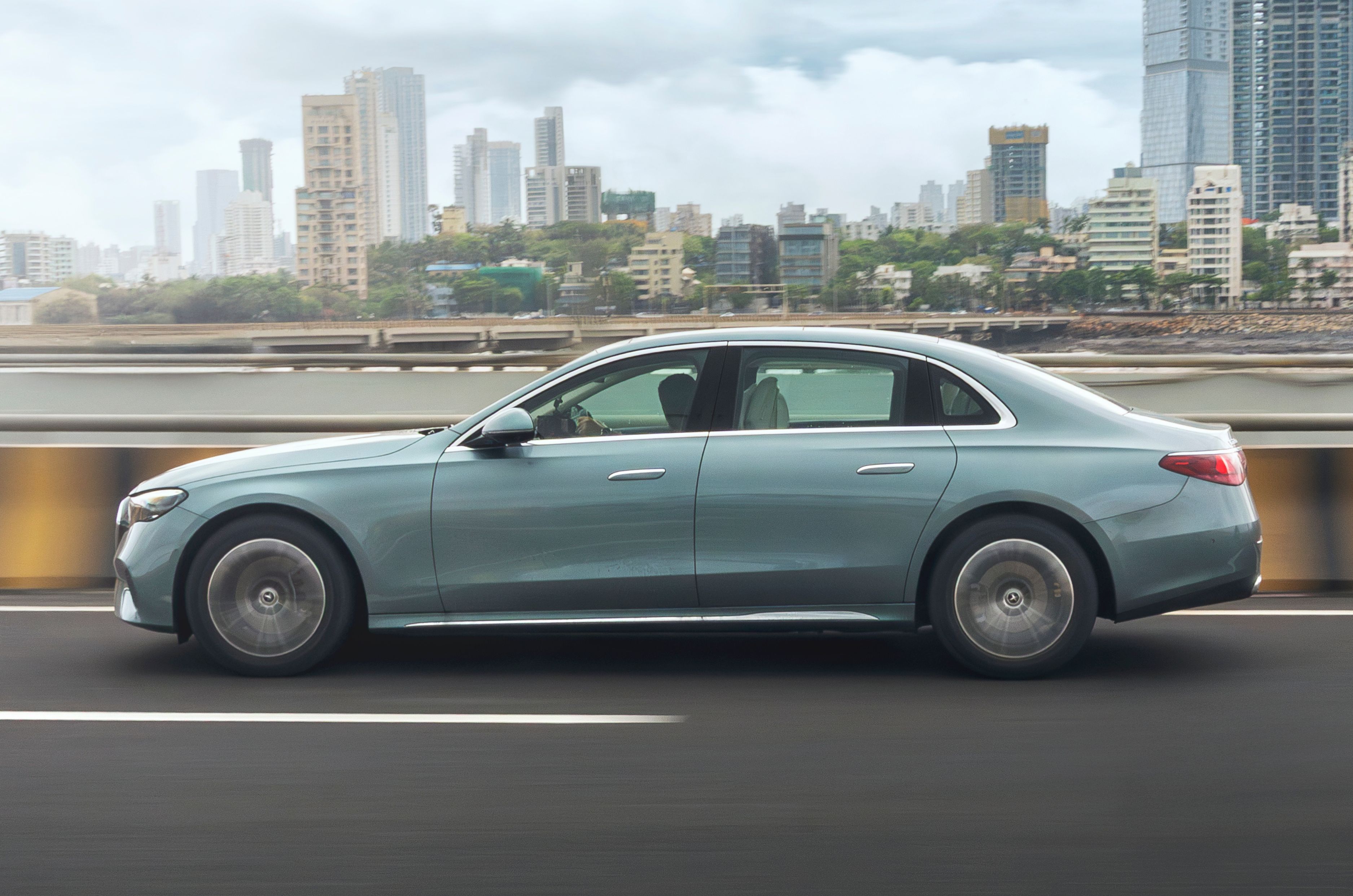The Mercedes Benz E-Class and the diesel engine go back 30 years in India. Since the launch of the W124 in 1995, the E-Class has been available with a diesel engine under the bonnet. Now, 30 years later, it remains the only luxury sedan in the segment to still offer the ‘D’ badge. Sure, it has its advantages, but is it still relevant in 2025?
Mercedes Benz E 220d Exterior Design and Engineering: 9/10
New paint shade adds flair; maintains elegance and sophistication

The diesel E-Class carries forward the exact same look as the E 200. Unlike the E 450 that’s available in the sporty AMG Line, the Avantgarde spec of the E 200 and E 220d is the more elegant choice. Even the wheels are identical, and the only way you can tell them apart is from the E 220d badge. To commemorate one year of the V214 generation of the E-Class, Mercedes has introduced a new paint shade, seen here. Dubbed Verde Silver, it is a welcome departure from the commonly seen blues and blacks, with a greenish tinge that adds more flair without going over the top.
Mercedes Benz E 220d Interior Space and Comfort: 10/10
Lots of room to stretch out; wide array of adjustment at the rear

On the inside, like the petrol variants, you can choose from three upholstery options: tan, cream, and full black. The dashboard is dominated by the ‘Superscreen’, which comprises a 12.3-inch driver display, a 14.4-inch centre touchscreen, and a 12.3-inch passenger touchscreen. The seats up front are comfy, broad, and offer lots of support, but miss ventilation. Instead, they offer seat kinetics; essentially, the seats make small adjustments to the lumbar and bolster supports at regular intervals, ensuring you don’t get stuck in a single posture on long drives. It’s subtle, but you will notice the changes depending on the intervals you set.

Rear seat space and comfort are excellent, and like the petrol version, there is no compromise on room. The backrests recline, the sunblinds for the windows and rear windshield are powered, the pillows on the headrests add comfort, and the split panoramic sunroof brings in airiness. There is also the ‘Chauffeur Pack’ as standard fitment, which includes controls for the rear left passenger seat to adjust the front passenger seat for more room. The rear centre armrest folds down to reveal a wireless charger and additional storage space. It is undoubtedly the best rear-seat experience in the segment.
Mercedes-Benz E 220d Features and Safety: 8/10
Well-equipped cabin in terms of luxury, but some features are missed

The E-Class is tech laden, and the diesel variant gets every feature of the petrol. The triple-screen layout, a Burmester 4D audio system (albeit only for the front seats), an in-car camera for video calls, an app library to consume content, four-zone climate control, digital AC vents, and much more. That said, some features you might expect, like ventilated seats and media controls for the rear, are missing. Additionally, the space-saver spare wheel mounted under the boot allows you to use the full 540 litres of boot space, large enough for a long weekend trip. The E-class also features ADAS with several sensor-based active safety assists, and unlike previous versions, if you don’t want to use them, they will remain switched off each time you start the car.
Mercedes-Benz E 220d Performance and Refinement: 8/10
Diesel engine not as smooth as petrol, but refined in isolation
Despite all of its rivals ditching the diesel engine, the E-Class carries on with one. The 2.0-litre turbo-diesel puts out 197hp and 440Nm of torque. While the power is just a tad less than the petrol, the 120Nm of extra torque is promising – at least on paper.

However, in an E-Class, refinement takes top priority, and in that respect, the engine isn’t perfect. There is an audible thrum at idle, and you can even feel some vibrations in the seat and on the steering wheel. Once you’re on the move, the noise fades but re-enters the cabin past 3000rpm. It’s not coarse, but it’s not silent either. Performance, while brisk, is linear, and lacks the same mid-range kick as pre-BS6 diesel engines. The 440Nm is well distributed and works seamlessly with the 9-speed automatic transmission, providing a gradual surge in every gear.
Performance times are extremely close to the petrol version, and the same goes for in-gear timing. That makes you wonder where the 440Nm is really helping.
The answer is on the highways. The added torque, which is available from lower RPMs, makes overtaking far more effortless in the E 220d than in the E 200 petrol, and this is despite the fact that both versions are equipped with a 48V mild hybrid system which provides some electric boost. The 9-speed automatic is quick to drop gears and get you past a truck or two, before quietly moving back up to 9th gear and resuming its silent cruise.
Mercedes-Benz E 220d Mileage and fuel economy: 9/10
Exceptional range and efficiency for a luxury sedan
While fuel economy might not be a top priority to many E-class buyers, the fact that you can get over 800km of range on a single tank is impressive. Not having to worry about topping up on your trip to the farmhouse or a weekend getaway – and not having to do it on the way back either – is the magic of the diesel engine. Yes, there is an Adblue tank that you need to be mindful of refilling from time to time, but if you frequently find yourself on highways for long spells, the diesel engine should be the de facto choice for you.
Mercedes-Benz E 220d Ride comfort and Handling: 9/10
Comfortable over weather-beaten roads and a surprisingly able handler
The diesel engine does add some weight overall, but that doesn’t disturb the ride quality, which remains planted and comfortable. The E 220d gets a standard steel suspension setup, with no room to actively adjust damping characteristics. Instead, it features what Merc calls an ‘Agility Control Suspension with Selective Damping System,’ which uses a series of sensors to adjust the suspension depending on the road surface. From behind the wheel, it seems to do a great job of blunting sharp bumps and keeping the car as level as possible over cracks and ruts.
Handling isn’t necessarily a standout strength for the long-wheelbase E-Class, but the steering is surprisingly sharp and responsive, and though light by default, gains more heft in sportier modes. While the car’s length is something to be mindful of, the E 220d is surprisingly nimble in corners. There’s no 4Matic AWD here, but a well-balanced chassis means there’s nothing to be nervous about in the bends.
Mercedes-Benz E 220d Price and Verdict: 8/10
The one to choose if you do regular inter-city drives

Thanks to the latest GST reforms, the E-Class has seen a price drop of around Rs 4.5 lakh for the diesel variant, which is now priced at Rs 85 lakh (ex-showroom India). Additionally, with no other diesel sedan rival, the E 220d has a niche in the market to itself as well.
However, the diesel, while impressive, lacks the ultimate smoothness of the petrol engine, but though there’s no real gain in performance from all that extra torque, it has an effortlessness the E 200 can’t match. What might also be a concern in regions like Delhi NCR is the shorter 10-year lifespan of diesel cars imposed by policymakers. This will no doubt affect the resale value of the E 220d, and if this is a concern, the petrol is a safer bet.
If this, and the relatively lower refinement, aren’t concerns for you, however, the E 220d remains the more practical and sensible pick of the new E Class range, as it has been for three decades.



